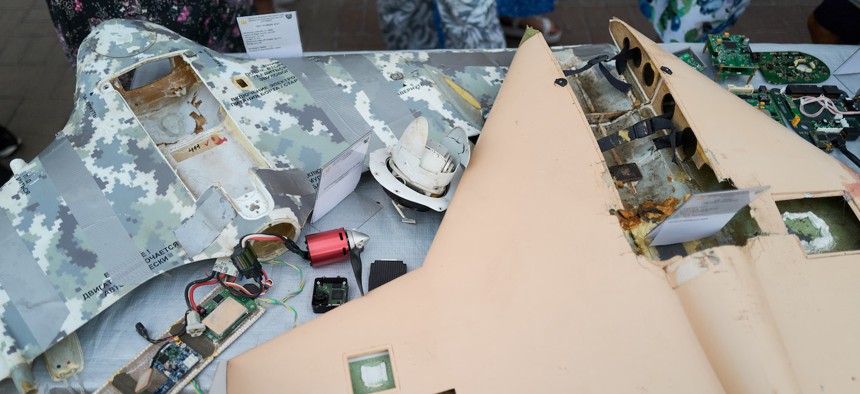SAM SKOVE

TALLINN—The Estonian army will soon stand up a unit solely dedicated to loitering munitions, drawing on lessons from the Ukrainian war, the battery’s prospective commander told Defense One.Estonian Land Forces Maj. Andrei Šlabovitš said he believed it would be the first unit of its kind in NATO, whose members have been watching the Ukrainian military’s extensive use of these one-way attack drones.
“Estonia is probably correct in saying they are the first to deploy loitering munitions,” said Larry Dickerson of Forecast International, a defense data and consulting firm owned by Defense One parent company GovExec.
“Others are also thinking about wider use of loitering munitions and how to best integrate them with their militaries,” Dickerson said. “The market is changing due to the press coverage loitering munitions are getting from the Russo-Ukrainian War.”
The U.S. Army is currently testing loitering munitions for use in infantry brigade combat teams, after first fielding them with Army Special Forces.
Šlabovitš said he was chosen to lead the company-sized unit because of his long experience with drones, including leading projects to integrate small drones into Estonian army units.
The Estonian unit will be tasked in part with taking out enemy anti-air emplacements. It will be equipped with Israel Aerospace Industries drones that are specially designed to seek out the radar signature of anti-aircraft systems.
Neither Israel or Estonia initially announced the specific drone selected for fielding, although photos provided in a May 2023 press release showed Harop and Mini-Harpy systems. Šlabovitš said Estonia would use the Mini-Harpy.
Šlabovitš said the idea came from studying the second Nagorno-Karabakh War, where Azerbaijan used Israel Aerospace Industries loitering munitions to destroy Armenian S-300 anti-aircraft systems.
Estonia is also learning heavily from Ukraine, the major said. He said that in addition to the military’s own assessments, members of Estonia’s Defense League, a military reserve force, have gone as civilians to Ukraine to learn from drone units during the war.
Among the top lessons for Šlabovitš is the importance of concealment in a battlefield in which the adversaries’ drones are always watching.
“Up to 10 kilometers from the front line, you can expect the enemy to see all your movements,” he said. “We need to think about how to move, how not to be seen.”
The Estonian Land Forces are already drilling on how to avoid being seen by drones, he said. The Baltic nation’s heavy forests are particularly helpful for concealing soldiers, he added.
Šlabovitš said the quantity of drones is more important than their quality, especially considering Estonia’s limited defense budget. Tallinn plans to spend just over $1 billion a year on its military through 2026, bumping defense spending up to an estimated 2.5 percent of GDP.
Ukraine loses as many as 10,000 drones a month, think-tank RUSI has reported. The losses are in part a reflection of just how many drones are in combat. One Ukrainian battalion commander told Defense One in May that his troops might have as many as ten drones in the air at any one time.
The Estonian army’s own experiments with small commercial drones began at least eight years ago, Šlabovitš said.
The reservists of the Estonian Defense League have been key, because many of its part-time soldiers brought in drones from their civilian life.
“It’s quite similar to how Ukraine did it,” he said. “It came up from the bottom, and our senior commanders understood it’s quite interesting,”
The Estonian Land Forces hope to eventually equip all infantry units with drones, with “at least one small drone at the platoon level,” said Capt. Taavi Laasik, a public affairs officer.
Estonia has developed a wide variety of add-ons to make these drones more effective, including packs to keep batteries warm in winter. That prolongs the battery life in temperatures that can drop to minus15 degrees, freezing a drone’s camera in place, said Šlabovitš.
Estonia, like Ukraine, also developed technology that can hide their drones from adversaries’ commercially available drone trackers, he added.
The use of such drones stands in stark contrast to U.S. policy, which forbids the use of quadcopter drones from DJI.
The U.S. has white-listed several manufacturers of small drones, but does not yet widely deploy small quadcopters in Army units. The Army began fielding its first quadcopter in December 2022, but the roll-out will take years, with the 3rd Infantry Division slated to get the quadcopters by 2026.
On the ground, that can mean Estonia’s forces at times have capabilities that outmatch those of the U.S., whose yearly defense budget is almost 1,000 times that of Estonia, a nation of 1.3 million.
Šlabovitš recounted how several years ago his unit operated in an exercise with a U.S. Marine reconnaissance unit, a special operations unit equipped with the latest gear. Told to scout an area, the Marines proposed moving toward the location.
“But we have a drone,” said Šlabovitš, laughing as he recalled the interaction. “Maybe we can use it.”
No comments:
Post a Comment